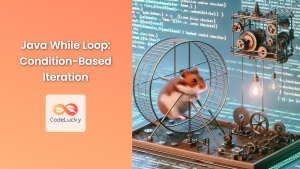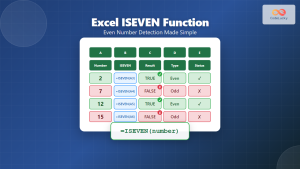In the world of programming, determining whether a number is even or odd is a fundamental task that every developer should master. This seemingly simple operation forms the basis for many complex algorithms and is frequently used in various applications. In this comprehensive guide, we'll explore multiple methods to check if a number is even or odd in Java, diving deep into the logic behind each approach.
Understanding Even and Odd Numbers
Before we delve into the Java implementations, let's quickly refresh our understanding of even and odd numbers:
- Even numbers are integers that are divisible by 2 without leaving a remainder. Examples include 0, 2, 4, 6, 8, and so on.
- Odd numbers are integers that are not divisible by 2 without leaving a remainder. Examples include 1, 3, 5, 7, 9, and so on.
Now, let's explore different ways to determine if a number is even or odd in Java.
Method 1: Using the Modulus Operator
The most common and straightforward method to check for even or odd numbers is using the modulus operator (%). This operator returns the remainder after division.
public class EvenOddChecker {
public static boolean isEven(int number) {
return number % 2 == 0;
}
public static void main(String[] args) {
int num = 7;
if (isEven(num)) {
System.out.println(num + " is even");
} else {
System.out.println(num + " is odd");
}
}
}
In this example, isEven() returns true if the number is even and false if it's odd. The logic is simple: if a number divided by 2 leaves no remainder (i.e., number % 2 == 0), it's even; otherwise, it's odd.
📊 Performance Note: This method is highly efficient and is the most commonly used approach in practice.
Method 2: Using Bitwise AND Operator
Another interesting approach involves using the bitwise AND operator (&). This method leverages the binary representation of numbers.
public class BitwiseEvenOddChecker {
public static boolean isEven(int number) {
return (number & 1) == 0;
}
public static void main(String[] args) {
int num = 42;
System.out.println(num + " is " + (isEven(num) ? "even" : "odd"));
}
}
Here's why this works:
- Even numbers in binary always end with 0
- Odd numbers in binary always end with 1
- The bitwise AND operation with 1 will always return 0 for even numbers and 1 for odd numbers
🧠 Bit Manipulation Insight: This method is particularly useful when working with low-level programming or when optimizing for performance in certain scenarios.
Method 3: Using Java 8 Streams (for a range of numbers)
If you need to check evenness for a range of numbers, Java 8 Streams provide an elegant solution:
import java.util.stream.IntStream;
public class StreamEvenOddChecker {
public static void printEvenOdd(int start, int end) {
IntStream.rangeClosed(start, end)
.forEach(n -> System.out.println(n + " is " + (n % 2 == 0 ? "even" : "odd")));
}
public static void main(String[] args) {
printEvenOdd(1, 10);
}
}
This method uses IntStream.rangeClosed() to generate a stream of numbers from start to end (inclusive) and then applies the evenness check to each number.
🌊 Stream Power: While this method might be overkill for checking a single number, it shines when processing a range of numbers efficiently.
Method 4: Using Recursion
For those who love recursion, here's a recursive approach to determine if a number is even:
public class RecursiveEvenOddChecker {
public static boolean isEven(int number) {
if (number == 0)
return true;
else if (number == 1)
return false;
else
return isEven(number - 2);
}
public static void main(String[] args) {
int num = 15;
System.out.println(num + " is " + (isEven(num) ? "even" : "odd"));
}
}
This recursive method works by repeatedly subtracting 2 from the number until it reaches either 0 (even) or 1 (odd).
⚠️ Caution: While interesting, this method is not practical for large numbers due to the risk of stack overflow.
Method 5: Using Math Class
Java's Math class provides an abs() method which we can creatively use to check for evenness:
public class MathEvenOddChecker {
public static boolean isEven(int number) {
return Math.abs(number) % 2 == 0;
}
public static void main(String[] args) {
int num = -6;
System.out.println(num + " is " + (isEven(num) ? "even" : "odd"));
}
}
This method is particularly useful when dealing with negative numbers, as it ensures the check works correctly for both positive and negative integers.
🔢 Negative Number Handling: Always consider how your method will behave with negative numbers!
Performance Considerations
When it comes to performance, the modulus operator method and the bitwise AND method are generally the most efficient. Here's a simple benchmark to compare their performance:
public class EvenOddBenchmark {
public static void main(String[] args) {
int iterations = 100_000_000;
long startTime, endTime;
// Modulus Operator
startTime = System.nanoTime();
for (int i = 0; i < iterations; i++) {
boolean isEven = i % 2 == 0;
}
endTime = System.nanoTime();
System.out.println("Modulus method time: " + (endTime - startTime) + " ns");
// Bitwise AND
startTime = System.nanoTime();
for (int i = 0; i < iterations; i++) {
boolean isEven = (i & 1) == 0;
}
endTime = System.nanoTime();
System.out.println("Bitwise AND method time: " + (endTime - startTime) + " ns");
}
}
The results may vary depending on the hardware and JVM implementation, but generally, both methods perform very similarly, with the bitwise method often having a slight edge.
Best Practices and Tips
-
Choose Readability: Unless you're working on performance-critical code, prefer the modulus operator method for its clarity.
-
Handle Edge Cases: Consider how your method will handle zero, negative numbers, and very large numbers.
-
Use Built-in Methods: For more complex number theory operations, consider using libraries like Apache Commons Math.
-
Test Thoroughly: Always test your even/odd checking methods with a variety of inputs, including edge cases.
-
Consider Type: Remember that in Java, integer division always results in an integer. Be cautious when working with floating-point numbers.
Conclusion
Checking whether a number is even or odd is a fundamental operation in programming. While the modulus operator method is the most common and generally recommended approach, understanding alternative methods can broaden your programming toolkit and help you in specific scenarios.
Each method we've explored has its own strengths:
- The modulus operator is clear and efficient.
- The bitwise AND operator can be useful in low-level programming.
- Streams offer an elegant solution for processing ranges of numbers.
- Recursion, while impractical for large numbers, demonstrates an interesting mathematical approach.
- The Math class method ensures correct handling of negative numbers.
By mastering these techniques, you'll be well-equipped to handle even/odd checks in various programming contexts. Remember, the best method often depends on your specific use case, so choose wisely based on readability, performance needs, and the nature of your data.
Happy coding, and may your numbers always align perfectly, be they even or odd! 🚀🔢



















